Please forgive what may look like a gratuitous photo of my cat, Elsa, but her appearance here does help to put the size of this Tanglewood Evolution TB Baby acoustic guitar into perspective. This is Tanglewood's answer to the Taylor Baby. With a scale length of approx 22 3/4", the TB Baby is intended as an acoustic travel guitar, but despite its small size it is a quality instrument as I hope these photos help illustrate.
I bought this particular Tanglewood Evolution TB Baby recently; it was brand new but I got it for about a third of the normal retail price. However - as is often said - "there's no such thing as a free lunch". In other words, there's a good reason why I got it so cheap.
It has a cedar top, mahogany back and sides, and mahogany neck with rosewood fingerboard, attractive maple binding and an abalone soundhole rosette.
Check the detail on the heel of the neck (below), with the abalone Tanglewood "T" set in a heel-cap of maple.
Tanglewood guitars are a British company, and you'll notice they proudly display "United Kingdom" on the back of the headstock...
...and also on the label inside the guitar. Despite this open display of "British-ness" I can't help thinking that the guitar was probably made out in China or elsewhere in the Far East. Note it doesn't actually say "Made in..." anywhere, and the United Kingdom references may just be to the nationality of the company. But this wasn't what I really wanted to talk about...
It's actually a very sweet sounding guitar, with a very pleasing tone, quite unlike that of a full size dreadnought. Unfortunately, this guitar has issues. As I believe is often a problem with short-scale guitars such as this, the intonation is way out. At first I wondered if the bridge saddle had been inserted the wrong way around, but I have checked it and it seems fine. What I am not so sure about, however, is the fretting. I don't know what you think, but to me the distance between the nut and the first fret appears to be too large for the scale being used here. Take a look at the photo below and see what you think?
I have tried playing with a capo at the 1st, 2nd and 3rd fret positions and it does perform a little better - you can actually play so that the guitar manages to play in tune with itself. Even better, I found, is to tune the guitar up a semi-tone and then use a capo. However, this is far from ideal because it means that we're having to deal with an even shorter scale and are being forced into playing in keys we might not want to play in.
Anyway, the guitar is - supposedly - designed to play in standard tuning. If I was forced to keep in permanently in another key, just tuning it up a semi-tone seems hardly worthwhile. Tuning up to G would seem more useful, but when I tried tuning up to G, the tension on the strings was just too much. Different gauge strings might be an answer, but then again they may intone just as badly.
The way I see it I have three options:
- Try the guitar with different gauge strings and see if a different tuning helps. However I'm almost convinced that this option will not bear fruit because I very strongly suspect that the intonation problem stems from the incorrect distance from nut to first fret having been used (my experiments with the capo would seem to confirm this), but it has to remain a consideration.
- Try the guitar with nylon strings which are known to be much more forgiving when it comes to intonation. And - yes - you can get nylon strings with ball ends nowadays, but the nut slots would need widening.
- Get someone competent to install a (tall) zero fret or maybe some kind of compensating nut such as an Earvana (although I'd prefer not to pay Earvana prices).
Does anyone have any further suggestions? Or maybe you have had intonation problems with a guitar like this? Please let us know via the comments below.
G L Wilson
© 2012, Guitarz - The Original Guitar Blog - now in its 10th year!


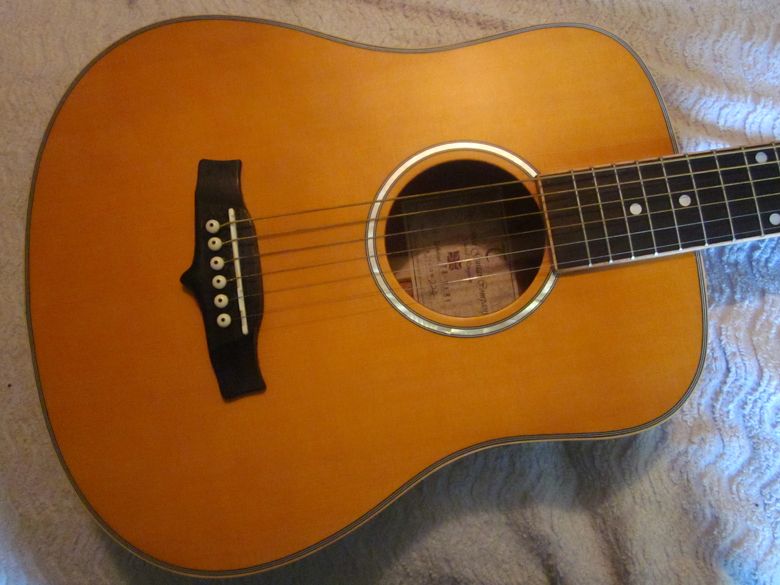
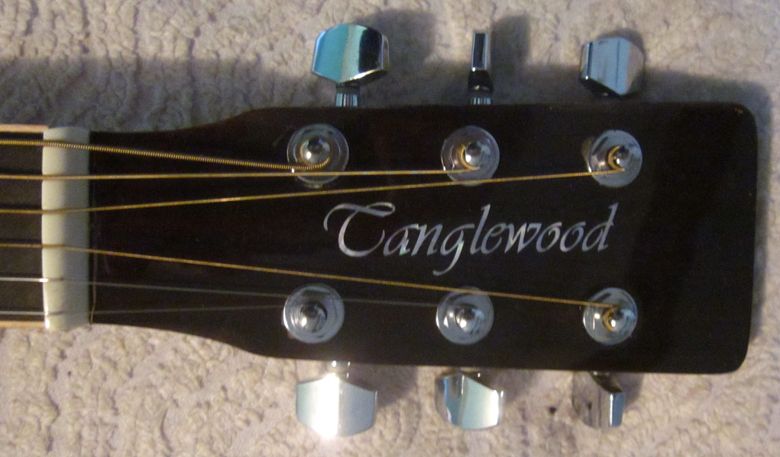
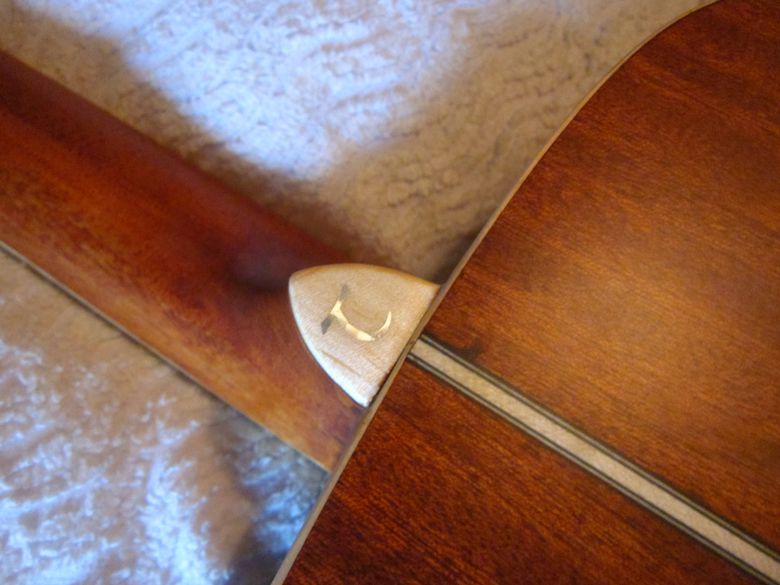
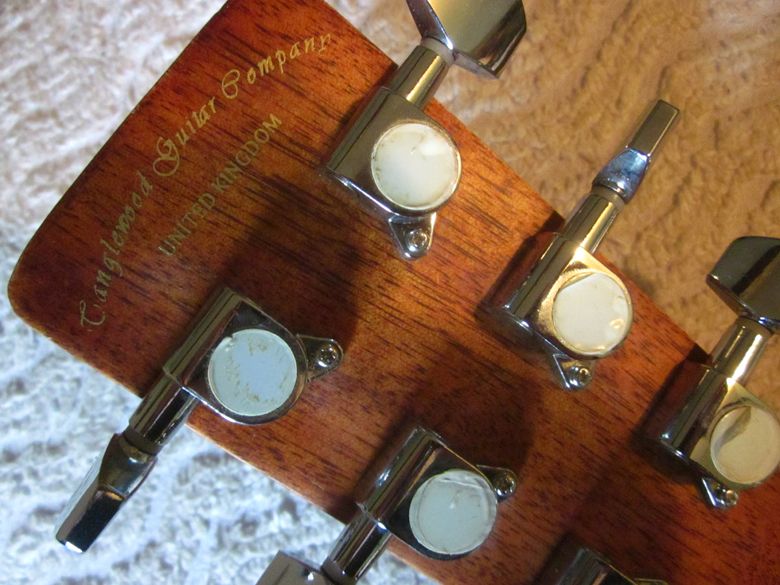

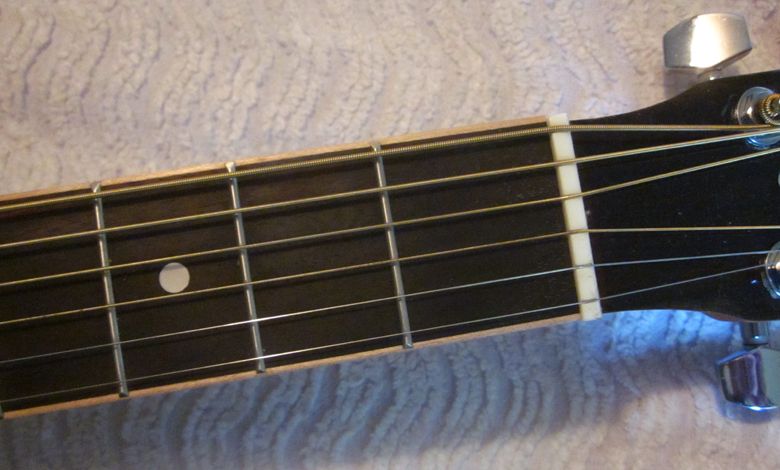
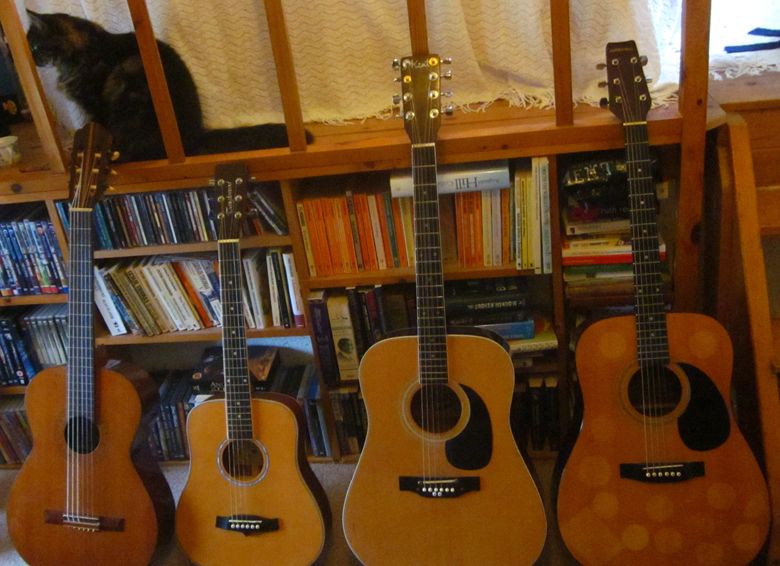
You could tune down and then capo up. That doesn't really solve anything, but at least you would get to play in standard tuning. If you do that, you could probably also put some thicker strings on it to make up for the lost tension, and to get a thicker tone.
ReplyDeleteBut your idea of having somebody competent install a zero fret may be the best idea. Or maybe you could get them to shave off a bit of the fingerboard and just move the nut.
I don't think tuning down would work. The intonation was at its worst in standard tuning, and was slightly better when tuned up. That implies that it would get worse still if going in the opposite direction.
ReplyDeleteYour idea of getting the end of the fingerboard shaved off and the nut moved could just work.
I'm not wrong, am I: the spacing between the nut and the 1st fret is far too large? Would you agree?
It does look off to me, but that might just be me obsessing over it after you pointed it out... The only way to really know would be to measure it using caliper or some other precise measuring tool.
DeleteStew-Mac has a calculator tool that does the distances between frets, which you can use to check.
http://www.stewmac.com/freeinfo/Fretting/i-fretcalc.html
What's the scale length supposed to be? Measure it and see what it actually is. If it is what it's supposed to be it's possible the whole fretboard needs removing, trimming at the 1st fret end and replacing to align the whole thing properly.
ReplyDeleteIf the scale length is longer than it's supposed to be then cutting a very short nut, glueing it to the fretboard at the right measured place before the first fret and removing the old one (sanding the little bit of redundant board behind would probably be needed too) would seem to be the cheapest option. I would say moving the bridge/saddle as an option if the scale's wrong but that gap between nut and 1st fret definitely looks too big and looks as though it could well be the root of the problem.
That'd be my uncertain diagnosis, anyway.
(Also if you do know the scale it's supposed to be you can calculate what the gap between the nut and 1st fret should be- http://www.stewmac.com/FretCalculator)
ReplyDeletehttp://windworld.com/features/tools-resources/exmis-fret-placement-calculator/#fretcalculator
ReplyDeleteZero fret is a good solution visually but the cheapest way is to actually move the nut closer to the first fret.Just measure the distance between the twelvth fret and the bridge then you'll get the distance between the twelvth fret and the nut. Then get a small square file and some "super glue" and do it yourself!
ReplyDeleteBingo!
DeleteI do like the zero fret idea for fast action.
I have a little First act wit 23 1/4" scale that gives me the same sort of fits.
time to bst out the calipers.
I like the zero fret idea.
DeleteHorse traded for a first act brand that looks like it came from the same factory.
23 1/4" scale. Same issues as your guitar. Need to get out the calipers and do some measureing.
I had the same issue on a cheap guitar acoustic guitar I bought a couple of years ago, it was also a little smaller in size and was sold as a "travelers guitar" if I remember correctly.
ReplyDeleteIt was impossible to play cause it was so badly intonated, I ended up removing the nut, trimming the fretboard and reinstalled a new (or the old I don't remember) nut and it solved the problem. I ended up giving it away but it still gets played and it still intonate right
and sound right.
So that's my 2 cents
thanks for all these cool guitars and info you guys provide
//Kenneth
I'm having some problems logging in on the new system. I'm logged in directly to the blog now the other options aren't letting me.
ReplyDeleteAnyway, I have a suggestion before you start cutting the fretboard and moving the nut. Check the measurements with the fret calculator then try slipping a sliver of, say, a matchstick under the string next the nut to create a false nut. Then you can double check before you start hacking away. It's a bit fiddly but I watched a luthier called Stephen Delft do exactly that (with a sliver of nut material) 20 odd years ago when he was trying to explain about compensated nuts to a friend of mine. This was years before the Earvana but I think it was invented by someone else even before Stephen. There's an article here and there was another by Stephen but it seems to have been taken down as all the links are dead ends. http://www.setitupbetter.com/Compensating-The-Nut.php The pity is Stephens article had some very clear pics.
I took my Ibanez 627-12 to a lutheir years ago for a similar problem, he made an adjustment to the bridge...
ReplyDeletehttp://aixelsyd13.wordpress.com/2011/10/09/my-guitars/ibanez-acoustic-full/
It's 3 separate little pieces now. Works quite well... looks like the opposite of the Earvana thing. I want to say it only cost me $60 or less? Maybe that included strings?
I think (though it may not manifest itself as huge if only a small mod is made) there is an issue with shortening the scale length by moving the nut forward as many of you are suggesting, as it does just that- shorten the scale length on a fretboard that (apart from the first fret gap) has been made to intonate for 22 3/4", not less or more.
ReplyDeleteIf the scale length is 22 3/4 and that gap is too big, in an ideal (and maybe more labour intensive) scenario that nut would remain where it is to retain the scale length and the fretboard would be trimmed and moved up to touch the nut with the newly corrected gap between nut and fret 1.
I had an old Harmony acoustic with a similar problem, but I think the cause was totally different. Someone replaced the original bridge with one made for nylon strings, but it was still strung with steel strings. I never bothered to repair it, because it had a lot of other issues besides that.
ReplyDeleteI forgot to mention that the bridge was warped and lifting off the body. Obviously that was what caused the intonation to go out of whack.
DeleteThe first fret definately seems too far, try to tune a string at the first fret then playing the 13th fret to see it its not also the bridge who isn't well placed or if its just the nut.
ReplyDeleteMove the nut, or make one that overhangs. A zero fret would be cool, but it's going to be difficult cutting a slot with the binding there. See if the frets match up against one of your other guitars. Hold them face to face, and slide them until the frets line up with each other. It might be a related scale.
ReplyDeleteDifficult to tell if the 1st fret is wrong but it does sort of look it.
ReplyDeleteTo calculate look at http://www.stewmac.com/freeinfo/Fretting/i-fretcalc.html - you can measure the scale length either by measuring it totally or I'd go for measuring from the nut to the 12 fret and doubling (that is straight to straight, if you get my gist). You can check your calc against some of the fret to fret values that this gives you and then check the nut to 1st fret.
If as suspected in essence the nut is too far back I'd go for moving the nut. To be honest I'd be tempted personally to have a go myself. Given you are removing some of the fretboard not adding to it I think that is easier.
So assuming it is out by say 2mm. Remove all strings. Remove the nut - best to GENTLY tap it with a small hammer against a piece of scrap wood held against the nut. They normally only take a couple of taps.
Carefully mark 2mm in and use a fine saw - a craft type one or thin tennon saw - to cut new position. Then use sharp chisel to remove the wood behind the new line a little at a time. Replace the nut with a couple of spots of superglue (only a little). Restring and Robert will be your Uncle.
BTW - Tanglewoods are all Far East manufacture without a doubt
My Crafter TRV travel guitar has a 22 3/4in scale length at the first string and a tad more at the bass [angled bridge]. Intonation is absolutely bang-on. Distance from the nut to the first fret is 1 and 1/4in, if that helps. BTW - Crafter's proud to be Korean.
ReplyDeleteKeep in mind that the usual method of determining scale length by measuring from the nut to the 12th fret won't work if the nut is in the wrong place.
ReplyDeleteThe gap looks too big, assuming there is no distortion in your camera lens. I'd find the approximate scale length and an online lookup table, and compare 1st and 2nd fret positions to be sure.
ReplyDeleteIf the fret position was out and it was my guitar I'd try making a zero fret as Bat Ta Lao suggests. Toothpick/match may suffice but also a length of wire coathanger could be shaped using files to make something to slip under the strings next to the nut. String pressure ought to hold it down but if it worked out for you then you could superglue it down. You could equally move the nut but of course a temporary zero fret involves no surgery.
If you are not confident of your skills in this department you can always consider the fact that as a guitar player you are, by default, "good with your hands" :)
Of course metal or a zero fret would make open strings sound different to if they were stopped by a plastic nut. This is not a concern to me, but your ears may be different! I replaced the cheap plastic bridge in a £20 acoustic with a length of wire coathanger and it makes for a very bright guitar!
@I'd find the approximate scale length and an online lookup table, and compare 1st and 2nd fret positions to be sure.
ReplyDeleteAsk and ye shall receive, http://www.stewmac.com/freeinfo/a-scalelength . The first part of this page is what you need most. Once you "know", what the scalelength is, the rest falls into place ;-)
what is the verdict oh great blogger in Wales??
ReplyDeleteWe wait with baited breath.
I took it into one of our local guitar guys to have a look at it. He agrees with me that the space from the nut to the first fret does look abnormally large but thinks that it must have been done for a reason. He can't believe a company of Tanglewood's reknown would have such sloppy production standards as to make a "mistake" like that on certain guitars only and not others. He suggested contacting Tanglewood directly and explaining the problem to them to see if they had anything to suggest.
ReplyDeleteIn the meanwhile, I have tried David's trick with the matchsticks and whilst it improves things a little, the intonation is still off.
So... I'm still working on it!
Can't really help but I remember seeing other makers also having similar issues where the positions are off. Still don't know why that is, I'm leaning to a production error because I can't see why two guitars of the same model would be made different like that for any good reason.
ReplyDeleteWell I'm off playing with matches now..
I've also bought one of these as a project and after countless measurements, it becomes clear that in my example, the fret board is 3.35mm too long at the nut. Of course this makes the top fret gap that much too big and once you add a new nut to bring it down by 3.35mm, you then have to alter the bridge position as for a scale length of 578mm.
ReplyDeleteAlso, the saddle was way too high and filing that down undernieth was the first job before I found that the fretboard position was the problem. http://www.stewmac.com/freeinfo/Fretting/i-fretcalc.html is great for checking all this - I worked back from the 1st to 12th fret to work out what on earth was wrong. Seemed unlikely that there would be two production errors, and in fact there is only one - unfortunately you have to alter both the nut and the bridge - you can't just re-router the saddle as the error is far too great. Good luck....
So carefully off with the bridge (very careful heat and fish slice), very careful clean off of the very thick glue (I have scalpeled back the veneer so it is a wood to wood join.
Then get the high E strint 580.015mm to the new nut position and low E string to 582.86mm. Obviously you can't measure those lengths - well I can't, but they are very close.
I am very happy to be able to report that I have just tuned up the strings after my fish slice routine and the intonation (12th fret harmonic v 12th string fret and by electronic tuner) is now as perfect as I can tell. Now just a bit of fret buzz, which I think is because of the truss rod a tad too tight and the saddle too low as a result of carving away the veneer to get a wood to wood joint under the bridge rather than the humungous thick origional glue which gap-filled between the wood to the bottom of the bridge.
ReplyDeleteIf you are handy, give this method a try. It has turned an un-playable guitar into a really nice traveller. Hope this all helps other buyers.
Oh dear, I just bought one of these off eBay and just waiting to collect after it's delivered. I'm worried now as I'm totally not confident with the prospects of having to do all this DIY discussed in theses posts. Would be great if a successful DIY job could be filmed and put on YouTube to give others s better idea of the processes involved.
ReplyDeleteOh well, I'm collecting tomorrow so I'm now not looking forward to recording my new guitar as I believe I won't be able to just tune up and play :(
I think mine was sold as having a defect, but I didn't notice it in the eBay listing until I'd bought it. Yours might be alright. Let me know how you get on.
DeleteMarvelous work pals, I love reading your articles.
ReplyDeleteultimate guitar
GL
ReplyDeleteI've just come across your post on the problems with your baby - I know whereof you speak! I have a baby I acquired in May ( s/n T021000162 ) which had really bad intonation problems.
I hope I'm not too late-but PLEASE don't even think of messing with the position of the nut - it is spot on believe me!
I'm going to post just this short comment to check I CAN post on here-then I will put a much longer post on to tell you what I did to turn it into a really lovely little guitar.
OK- so far so good.
ReplyDeleteI bought mine as a travel beater for our annual jolly jape to florida, then realised it had to go as hold luggage as its too big for Virgin airways to consider it "hand luggage". Bad plan.
SO Id bought it, and thought I may as well make the best of a bad thing (Pretty little guitar though!). First reaction was that the intonation was WAY out - looking at the HORRIBLE saddle made me marvel at what wonderful work 21st century man could do with his teeth; the saddle was a good 1mm too thin for the bridge and was sitting at a jaunty angle of approximately 40 degrees off vertical; so there was the FIRST suspect!
I cut a new shinbone bridge (do with most guitars as I like my own) and tried with an old set of elixir 12s. Close, but no ceegar as they say.
SO I then turned my attention to the nut. Once again, that guitar techs teeth had been BUSY!! The nut was (as with most low range guitars) WAY too high - and of a particularly unpleasant form of molded plastic which doesnt respond well to ssuch things as .....oooh nut files, for example.
I also noticed that the string spacing was -err- ever so slightly out, as the bass (6) string was WAY too close to the edge of the fret board. SOooo- off comes the nut and I replaced it with a hand cut ebony nut (I'd run out of cowbone- sue me).
A bit of judicious work with the new fret files (been meaning to buy new ones for YEARS) and I had a guitar with a MUCH better intonation, but a truly BIZARRE action.
So I took the strings off (again) and checked the fret level on the untensioned neck- and to be honest, I reckon they had been knocked in by John Henry hisself (probably using the fabled 9 pound hammer). It is for SURE they had never seen a competent guitar tech anywhere near them. SO I dressed and reshaped a couple around the 7th 10th and 12th fret.
Then I put the strings back on and checked the neck relief- the truss rod had been tensioned in REVERSE, so I was practically playing a longbow. More work.
The final touch, when everything came together was when I put a set of 13 gauge China Alice phosphor Bronze strings on the little blighter
-AND SHE SUNG!!!!
A few tweaks afterwards - I find I get a better play from this guitar in open d tuning (I'm learning a few Masake KIshibe pieces, so its handy to haave it lying round ready to play. If I am playing in standard tuning, I tend to tune two semis high to keep the tension on the short strings. (remember, a shorter string length needs a lower tension to hit the same note)
All these guitars needed in the factory was a little TLC and a good setup that any half competent player (let alone TECH) could have achieved. ITs frankly disgraceful that they were let "into the wild" in this condition, and I am forced to say, it is MOST unlike Tanglewood.
I own a beautiful Nashville III that was my first guitar purchase in 30 years (my Yamaha FG110 has always been enough for me, but shes not up to Bluegrass). These guitars however, were NOT so good, and its a damned shame, as they CAN be. D-18s they AINT, but thats not what youd expect of a travel guitar.
I realise that I may have made it sound as though I repair guitars professionally, but really I am just a guy who likes to play, and can use basic hand tools. SO my advice would be, if you CAN do this yourself, read around on the internet, and try to salvage a good guitar from a very average attempt by the maker. If you CANT or would prefer not to, suggest you find a good luthier who will give your baby the seeing to she so rightly deserves!
Good to see these helpful information here, Thanks lots for sharing them with us.
ReplyDeleteTanglewood Construction company
Quality home builder in Tanglewood
Thanks for sharing information.Your blog has always been a source of great tips.
ReplyDeleteTanglewood builders
Price for custom homes in Tanglewood
Your method of explaining in the blog that’s superb I have now words to praise your blog.
ReplyDeleteTanglewood builders
Tanglewood Construction company